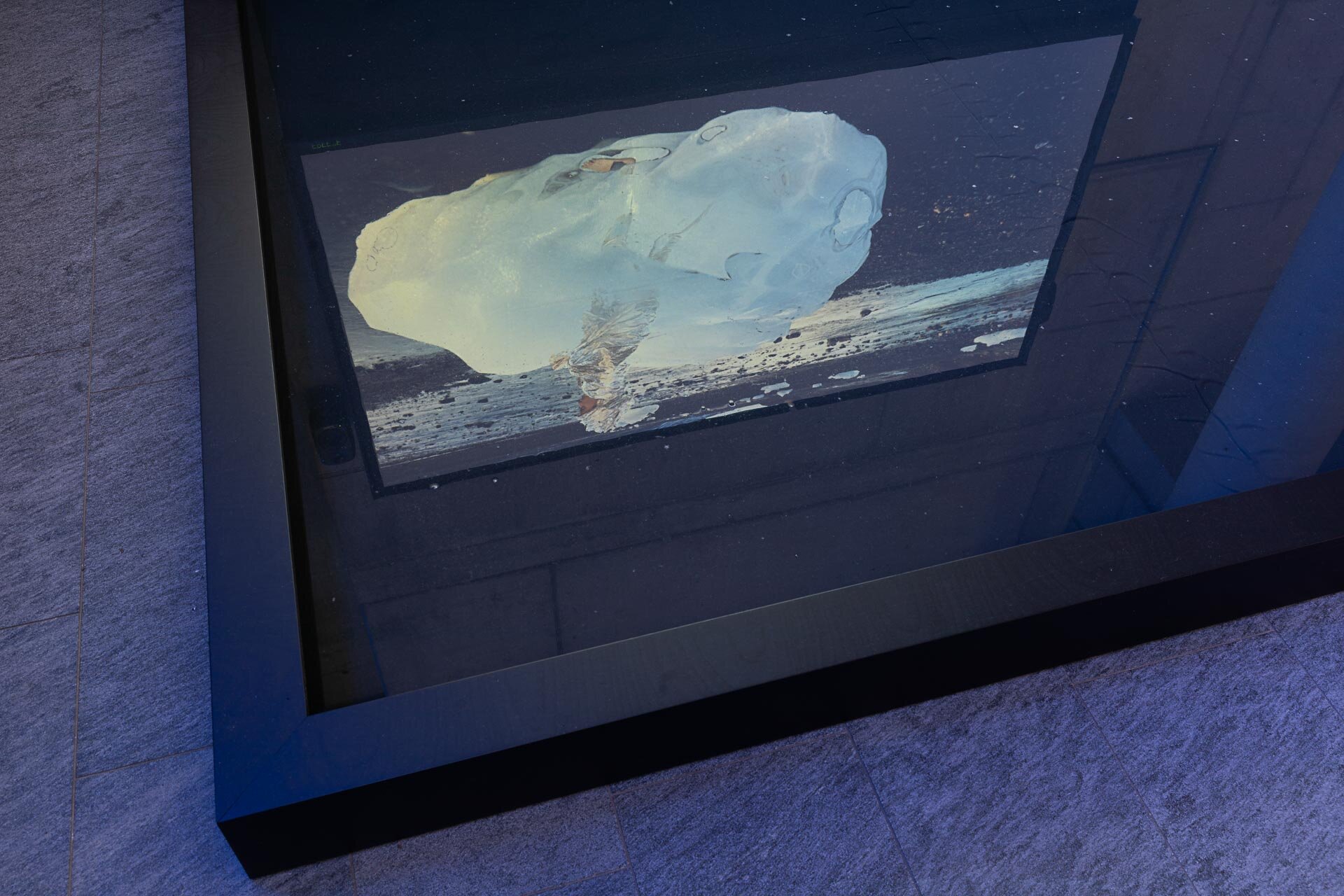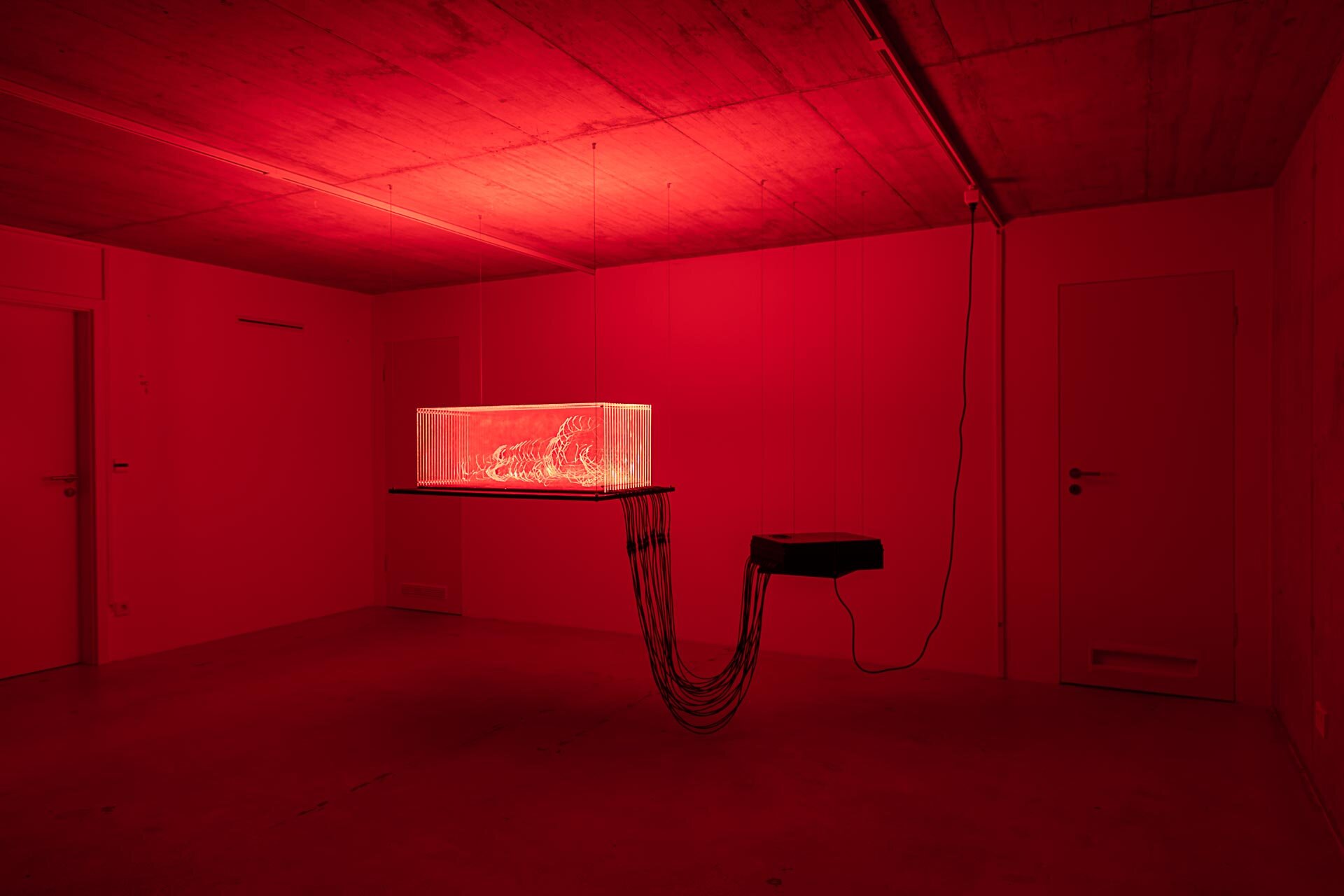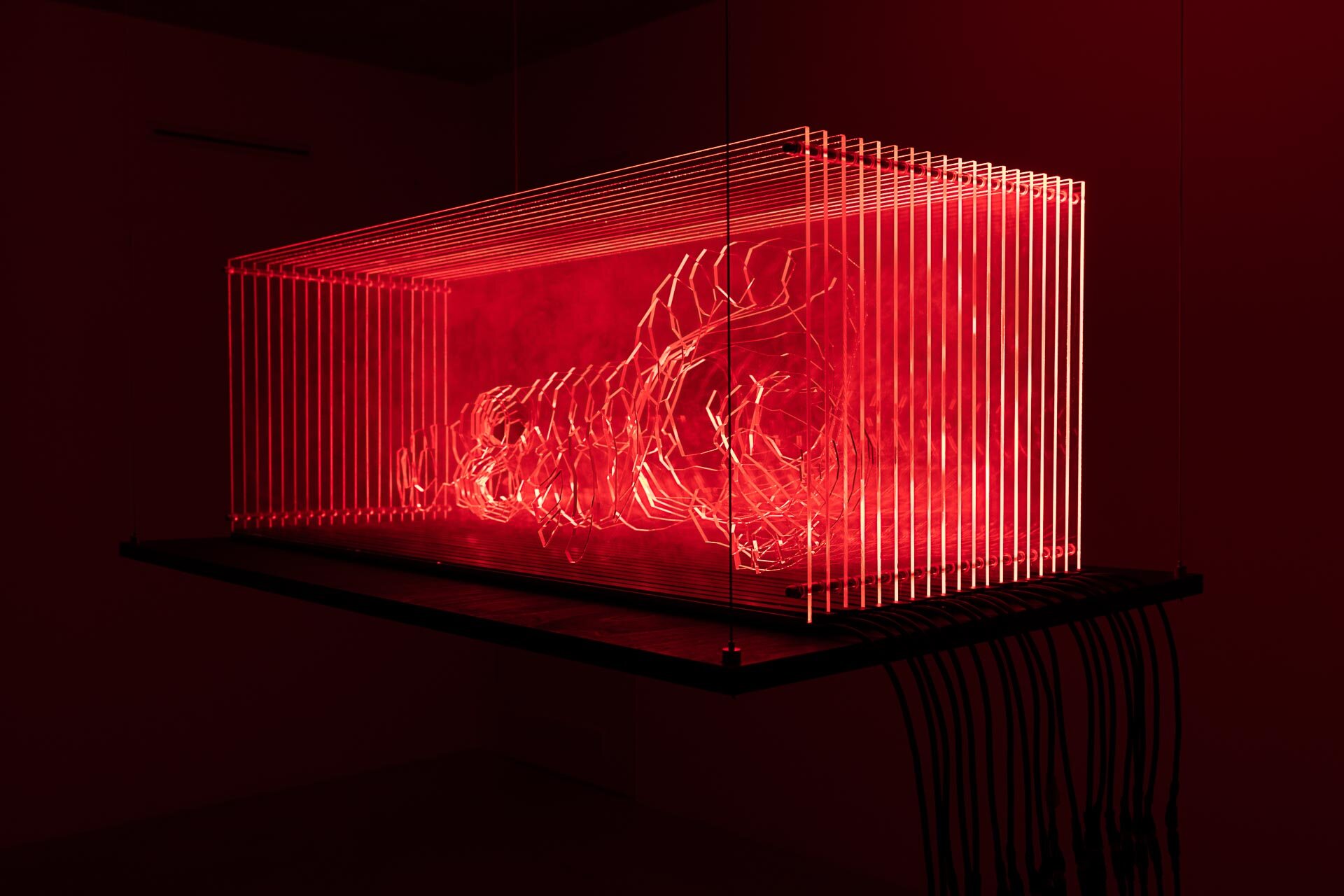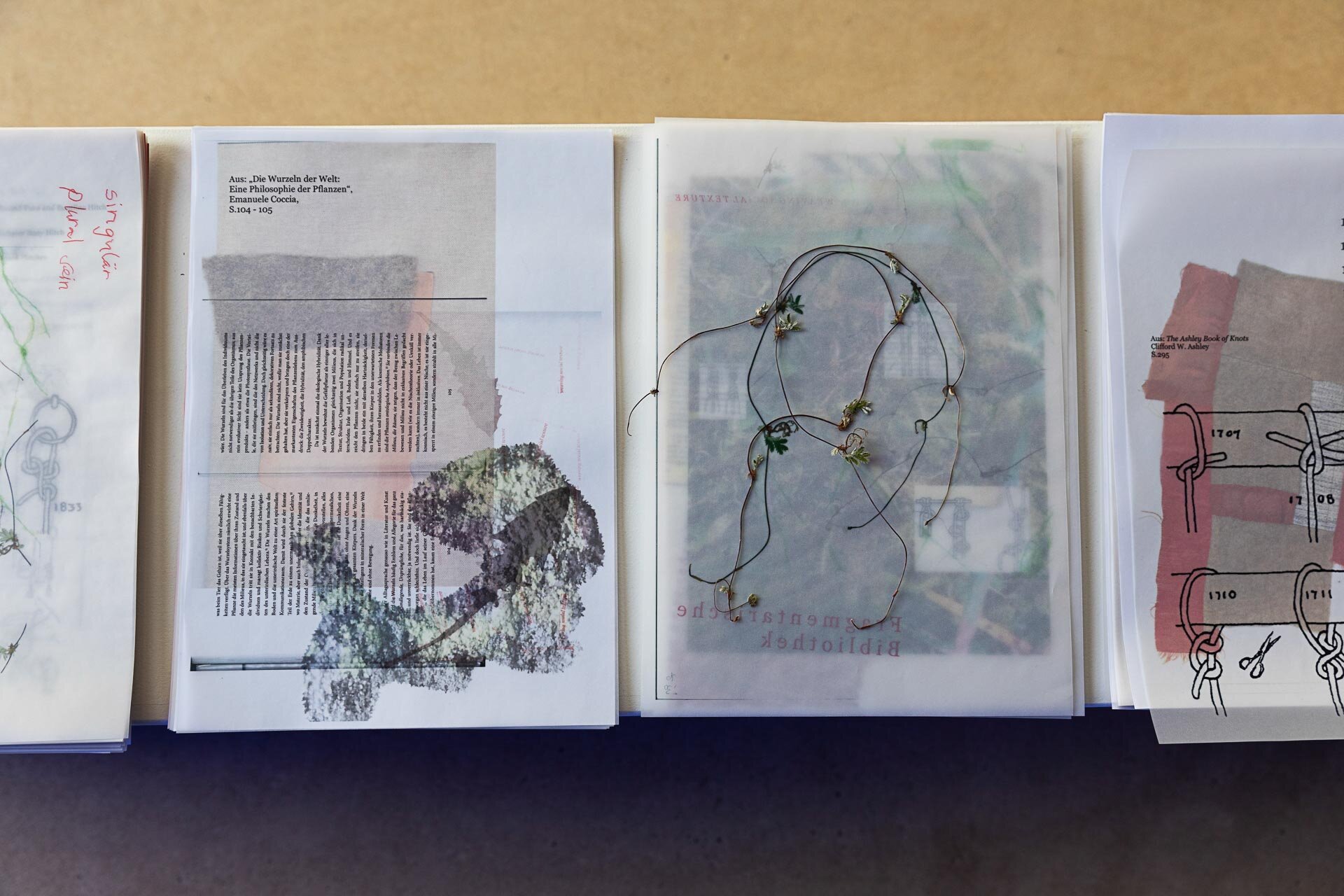Hypertopia
Online Exhibition
The change in the world cannot be pinpointed. Even the shaking of its order, which feels as though it has only increased in recent times, is not restricted to specific areas or zones, and certainly not to any nation. The systemic crisis, whose causal relationships we are only just beginning to understand, is omnipresent, but remains out of our reach. Transcendent and translucent, the term Hypertopia may appear to be heaven condensed into a word, but is actually derived from this supra-localization. The implicated swirling omnipresence is a part of the crisis as much as our hope of making the best of it.
© Eike Walkenhorst
Hypertopia’s curatorial concept combines the notion of collective consciousness with that of the conscious collective, in order to bring awareness to the interdependence of actions, actors, disciplines and different times. As a journey between past, present and future, the exhibition combines artistic positions, propositions and explorative projects. This allows for the different narratives to manifest themselves like a network in space that simultaneously confronts and mends — strains and releases. Symbiotic coexistence confronts instrumentalized ecosystems in a biosynthetic future. Data activism meets fictional narratives from non-humans. Humans are dissected and reassembled in search of the origin of our being.
© Anne Freitag
© Eike Walkenhorst
Instead of providing instructions or even answers, the program traces and investigates how an enduring moment in a perceived state of emergency can become a transformative factor that encourages sustainable action between humans, nature and technology. To cultivate a breeding ground for an organic network of ideas, Hypertopia presents thought experiments that counter the ecological, geological and socio-political challenges of our time with a new, collective optimism.
© Linus Kaufhold (Instagram @seeberg_embrace) / STATE Studio Hypertopia
Fieldwork
Hypertopia is a borderless territory. Hence, the exhibition is accompanied by a decentralized framework program that carries its ideas into the public realm, from the gallery space into open terrain. Instead of sticking to conventional panels or patterns of thought, the participatory format sends visitors on the road; starting from the exhibited artworks, they are given basic instructions to gather clues for fresh momentum. Besides self-guided trips (first directions can be found in the gallery space in the form of QR codes), special group tours will take participants to relevant referent points in the city. With STATE Studio, all excursions have a common point of departure. From there, all forge their own individual paths.
Himali Singh Soin:
We Are Opposite Like That
Himali Singh Soin’s video piece we are opposite like that pairs poetry with archival material and a mythical soundscape to recount the fear of an imminent glacial epoch that was omnipresent in Victorian England. Inspired by ancient field recordings, an original score for string quartet reinterprets the sound of ice plates crashing into each other, the drone of a boat, the polar winds. Including melodic fragments of Victorian composer Edward Elgar’s The Snow (1895), the elaborate sound design creates a chamber of resonances that reflects a potential, post-human future. Commissioned by the Frieze Artist Award 2019, the video forms part of an ongoing series of interdisciplinary works on the mythologies for the poles, told from the non-human perspective of an elder that has witnessed deep time: the ice. Beckoning the ghosts hidden in landscapes, the series invites us to listen in on the resonances of polar pasts and potential futures.
Credit: Anne Freitag
© Eike Walkenhorst
© Eike Walkenhorst
Daisy Ginsberg:
Designing for the Sixth Extinction
© Otto Felber
While conservationists struggle to protect existing ‘natural’ species and reverse the effects of the Anthropocene, synthetic biologists are busy engineering new organisms. Designing for the Sixth Extinction investigates synthetic biology’s potential impact on biodiversity and conservation. The project imagines a possible future, in which novel companion species are designed to support endangered natural species and ecosystems. Ginsberg proposes different types, including a slug that leaves a trail of alkali to neutralize acidic soil, and a porcupine with sticky rubber spines that would help disperse seeds of threatened plants. Modeled on fungus, bacteria, invertebrates and mammals, these species are released into the wild, raising a set of ethical questions: What would the ‘wilds’ look like in a synthetic biological future? Can we ‘preserve’ by looking forward? If nature is totally industrialized for the benefit of society, will nature still exist for us to save?
© Eike Walkenhorst
© Otto Felber
Dr. Alexandra Daisy Ginsberg examines our fraught relationships with nature and technology. Through artworks, writing, and curatorial projects, Daisy’s work explores subjects as diverse as artificial intelligence, exobiology, synthetic biology, conservation, biodiversity, and evolution, as she investigates the human impulse to “better” the world. She is lead author of Synthetic Aesthetics: Investigating Synthetic Biology’s Designs on Nature (MIT Press, 2014), and in 2017 completed Better, her PhD by practice, at London’s Royal College of Art (RCA), interrogating how powerful dreams of “better” futures shape the things that get designed. She studied architecture at the University of Cambridge, was a visiting scholar at Harvard University, and received her MA in Design Interactions from the RCA. Daisy exhibits internationally, including shows at MoMA New York, the Museum of Contemporary Art, Tokyo, the National Museum of China, the Centre Pompidou, and the Royal Academy. Her work is in museums and private collections. Talks include TEDGlobal, PopTech, Design Indaba, and the New Yorker Tech Fest.
Artwork loaned by ZKM | Zentrum für Kunst und Medien Karlsruhe
Digital Field Trip
Salvatore Laconesi and Oriana Persico:
Obiettivo
© Eike Walkenhorst
© Anne Freitag
The first material outcome of a greater project called Datapoiesis, Obiettivo is designed as a warning light system for public spaces. Fed with data sourced from international organizations, it reacts to the number of people living in extreme poverty. The red light emitted by the object is an alarm; Obiettivo is a “totemic object”, designed to raise awareness and make us more sensitive towards one of our planet’s most threatening and complex issues. Built to be installed in public space, the prototype aspires to become a pole for urban neo-rituals, to promote shared action, a new mode of collective responsibility, supported by technologies and science. Datapoiesis, Obiettivo’s collaborative umbrella project, focuses on the production of data-based art and design that fosters new relationships within our globalized world.
The artistic team Salvatore Iaconesi and Oriana Persico observe the mutations of human beings and societies in the advent of new technologies and ubiquitous networks. With projects poised between poetics and politics, bodies and architectures, squats and revolutionary business models, the duo promotes a vision of the world in which art connects science, politics, and economics. Iaconesi is a robotics engineer, hacker, interaction designer, a TED, Eisenhower, and World Yale Fellow. Persico is a digital communication and inclusion expert and cyber-ecologist. Together, they are authors of global performances, publications, and artworks that have been exhibited all over the world. They founded the Rome-based research center Human Ecosystems Relazioni (HER) as well as the international network Art is Open Source (AOS), which is dedicated to the interconnections between art, science, and technology.
Ani Liu:
Untitled (A Search for Ghosts in the Zoom Machine)
© Eike Walkenhorst
The idea of being human is an unstable construct. Recent technological innovations allow us to redesign ourselves profoundly— from networked prosthetics and artificial intelligence to the genetic code of life itself. Can our behaviors be reduced to algorithms? Can our bodies be upgraded with nonorganic integrations? Can sentience itself be manufactured in a lab?
The original series Untitled (A Search for Ghosts in the Meat Machine) comprises nine sculptures that examine personhood from anatomical, psychological, genetic, biochemical, behavioral, algorithmic, personal narrative and memory. Each sculpture is as tall as the artist, and each glass vitrine holds her liquid volume. But besides these basic dimensions, every piece is configured individually to represent one specific organ, body part, or intellectual capability generally considered to distinguish us as a species. For Hypertopia, Liu created one custom vitrine, continuing her emotional confrontation with being quantifiable.
© Eike Walkenhorst
© Eike Walkenhorst
Ani Liu is a research-based artist working at the intersection of art and science. Her work examines the reciprocal relationships between science, technology and their influence on human subjectivity, culture, and identity. Ani's work has been presented internationally, including the Venice Biennale, Ars Electronica, the Queens Museum Biennial, Boston Museum of Fine Arts, the Asian Art Museum, MIT Museum, MIT Media Lab, Mana Contemporary, Harvard University, and Shenzhen Design Society. She holds a B.A. from Dartmouth College, a Masters of Architecture from the Harvard Graduate School of Design, and a Master of Science from MIT Media Lab. Ani is passionate about integrating multidisciplinary approaches into her practice and is currently teaching at Princeton University. Her studio is based in New York City.
Dominique Koch:
Holobiont Society
A dense artistic research project, Holobiont Society delves into a complex set of issues related to hierarchies, power structures, and concepts of coexistence – such as the eponymous ecological unit of the holobiont. Initially defined by Dr. Lynn Margulis in her 1991 book Symbiosis as a Source of Evolutionary Innovation, the concept collection of prokaryotes, all of which contribute in some way to the function of the whole. In Koch’s film, the holobiont is visualized by scientific images of corals, bacteria and other symbiotic organisms. The video’s elaborate sound design synergizes with fragments of interviews with the biologist, feminist, and acclaimed writer Donna Haraway and the philosopher and sociologist Maurizio Lazzarato. Interweaving image, sound and text in a multilayered assemblage, Holobiont Society challenges current mechanisms of domination and categorization, in favor of fresh modes of thinking and being in the world.
Credit: Anne Freitag
© Eike Walkenhorst
Credit: Anne Freitag
Dominique Koch (*1983 in Lucerne, Switzerland) lives and works between Basel and Paris. From 2004 to 2011 she studied photography at the Hochschule für Grafik und Buchkunst in Leipzig, Germany. Her multilayered installations can be described as discursive laboratories. In her practice, the artist integrates various fields of research to form intricate networks of knowledge, in which philosophy, molecular biology, neo-Marxism, and science fiction meet. Her solo exhibitions include “Holobiont Society” at CAN, Centre d’art Neuchâtel (2017), “Maybe We Should Rejuvenate the Words rather than the Bodies” at Rinomina, Paris (2016), as well as “Beyond Chattering and Noise” at Centre Culturel Suisse, Paris (2015). Amongst her most recent group shows are “Protozone: Contamination/Resilience”, Shedhalle Zürich (2020), “WE HYBRIDS!“, Istituto Svizzero di Roma (2020), “Mycelium as Lingua Franca”, A Tale of a Tub Rotterdam (2019), „Trees of Life“, Frankfurter Kunstverein (2019) “Futurs Incertains“, Musée d’Art de Pully (2019), “An Eye Unruled”, Swissnex San Francisco (2019).
Jana Dohmann:
Weaving Social Texture
© Eike Walkenhorst
Weaving Social Texture is a collective research project that seeks to inspire interaction. Over the course of her show, the participatory installation will grow into a collective tissue of decisions, all of which are driven by individual, or mutually coordinated choices. A basic set up pre-installed by the artist serves as a point of departure for the collective, essentially improvised work. Further reference is provided by a set of scores, that frame the action, adding a few fundamental guidelines for the visitors to carry out. Everything else derives from the moment, from free decisions, acts and deeds – that is, from participatory typing, knotting, and interweaving. The explorative situation is supported by a fragmentary reference library, holding ready a subjective anthology of ecological, philosophical, and cultural knowledge. The resulting sculptural structure investigates the potential of collectivity and social negotiation – and thus raises a question on which the future of our planet depends.
© Linus Kaufhold (Instagram @seeberg_embrace) / STATE Studio Hypertopia
Credit: Anne Freitag
© Eike Walkenhorst
© Eike Walkenhorst
Jana Maria Dohmann is an independent artist and art mediator living and working in Berlin. Her intermedial practice hovers between performative research, somatic methodology and installation art. Based on poetic scores and experimental arrangements, her participatory sculptures explore issues of collectivity, collaboration, as well as the element of physical touch. Jana‘s work has been shown at Kunstverein Kärnten, Galerie KUB, Leipzig and the Somatic Academy, Berlin. As part of her collaborative practice, she has worked as a performer for Tino Sehgal at the Volksbühne Berlin and Albertinum in Dresden. Her solo show “PAYBACK” is currently on show at Galerie Sindelfingen. She developed a format for performative art mediation for documenta14, has worked with the Boros collection and is presently attending the MA program “Cultures of the Curatorial” at HGB Leipzig.
Curious Minds:
Unrecognised Borders of Transient Beings
© Ashley Middleton
When whales die, their carcasses sink down to the ocean floor, giving rise to complex ecosystems that supply sustenance to hundreds of deep-sea organisms for decades. Drawing on inspiration from the so-called Whale Fall, Unrecognised Borders of Transient Beings navigates the body as a porous and integrated ecological site. Through video, sound, surveillance technologies, and coded networks, the work invites participants to reframe their presence in an alternative environment, providing a contemplation site for the following questions: What kind of assemblages do we engage in consciously/unconsciously and physically/metaphysically? How does our body loop into the environment and what kind of micro choices have macro effects on ourselves and the world around us? What systems do we utilize to navigate differences? Do we need to create new systems of communication that facilitate a wider integration between human and non-human bodies?
The community platform Curious Minds challenges the boundaries of conventional knowledge production to promote new ways of learning and collective thinking. Conceived at STATE as an open environment that builds and fosters meaningful connections and engages in creative experimentation, the community works in small transdisciplinary teams on the tricky problems of our times. With backgrounds in the arts, science, technology and the humanities, Curious Minds’ members have the opportunity to contribute to STATE Studio's program. For Hypertopia, the explorative group project Unrecognised Borders of Transient Beings was developed by a Deep Dive Collective including Andrea Rassell, Ashley Middleton, Bella Spencer, Catri Foot, and Juho@ArtCalmCorner.
Credit: Ashley Middleton
Artists
Hypertopia is realized with the support of Haupstadtkulturfonds.
Program partners
EIGEN + ART Lab, AI for Good, Science Notes Magazin and Berlin Science Week.
TEAM
Artistic Direction
Christina Hooge, Johanna Teresa Wallenborn, Christian Rauch
Administrative Management
Victoria Domke
Co-curation Exhibition and Program
Anna Sinfozik, Christian Rauch, Christina Hooge, Fotini Takirdiki, Johanna Teresa Wallenborn, Martin Müller
Head of Communication
Johanna Teresa Wallenborn
Press and PR Anna Sinofzik
Editors
Anna Sinofzik, Fotini Takirdiki
Head of Production
Christina Hooge
Production assistance
Dora Sasvari, Veronika Natter
Exhibition Design and Production
Nils Höpken, Tobias Baaß
Technical Production
Filippo Vogliazzo, Davide Luciani
Digital Production
Lise Ninane
Social Media
Marque Pham, Hanna Kaufhold
Video Production
Hiroo Tanaka, Linus Kaufhold
Graphic Design
Anne Büttner, Studio Büttner




































